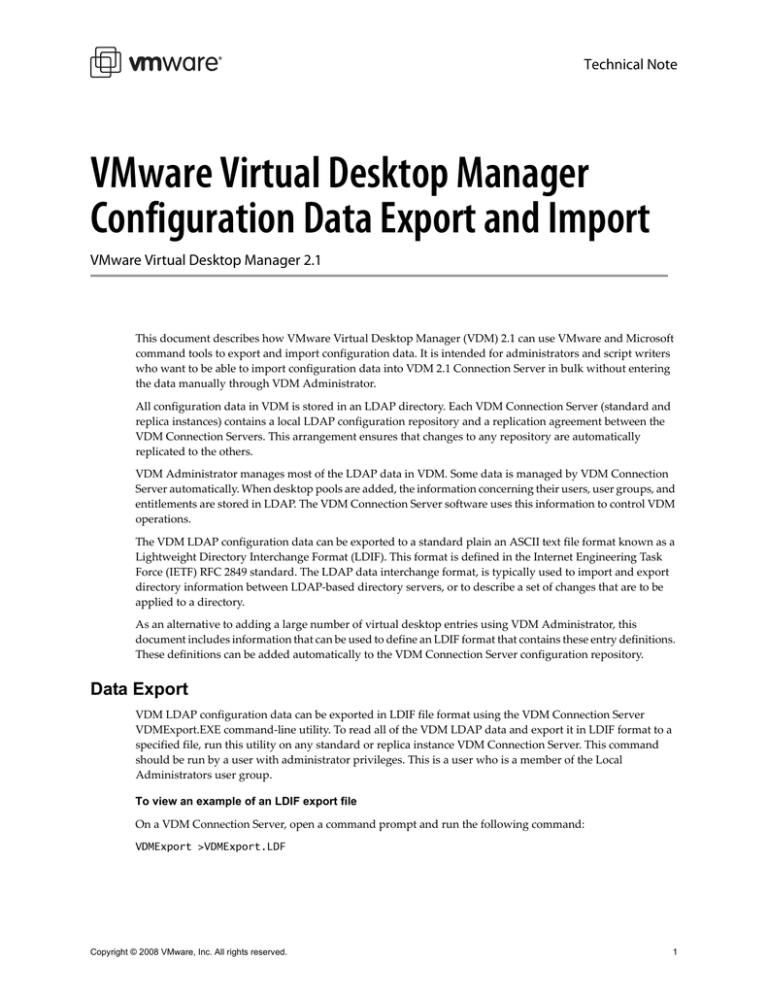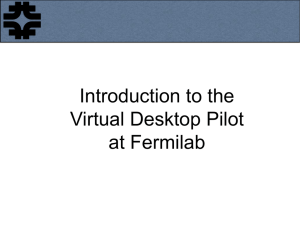
Technical Note
VMware Virtual Desktop Manager
Configuration Data Export and Import
VMware Virtual Desktop Manager 2.1
This document describes how VMware Virtual Desktop Manager (VDM) 2.1 can use VMware and Microsoft command tools to export and import configuration data. It is intended for administrators and script writers who want to be able to import configuration data into VDM 2.1 Connection Server in bulk without entering the data manually through VDM Administrator.
All configuration data in VDM is stored in an LDAP directory. Each VDM Connection Server (standard and replica instances) contains a local LDAP configuration repository and a replication agreement between the VDM Connection Servers. This arrangement ensures that changes to any repository are automatically replicated to the others. VDM Administrator manages most of the LDAP data in VDM. Some data is managed by VDM Connection Server automatically. When desktop pools are added, the information concerning their users, user groups, and entitlements are stored in LDAP. The VDM Connection Server software uses this information to control VDM operations.
The VDM LDAP configuration data can be exported to a standard plain an ASCII text file format known as a Lightweight Directory Interchange Format (LDIF). This format is defined in the Internet Engineering Task Force (IETF) RFC 2849 standard. The LDAP data interchange format, is typically used to import and export directory information between LDAP‐based directory servers, or to describe a set of changes that are to be applied to a directory.
As an alternative to adding a large number of virtual desktop entries using VDM Administrator, this document includes information that can be used to define an LDIF format that contains these entry definitions. These definitions can be added automatically to the VDM Connection Server configuration repository. Data Export
VDM LDAP configuration data can be exported in LDIF file format using the VDM Connection Server VDMExport.EXE command‐line utility. To read all of the VDM LDAP data and export it in LDIF format to a specified file, run this utility on any standard or replica instance VDM Connection Server. This command should be run by a user with administrator privileges. This is a user who is a member of the Local Administrators user group.
To view an example of an LDIF export file
On a VDM Connection Server, open a command prompt and run the following command:
VDMExport >VDMExport.LDF
Copyright © 2008 VMware, Inc. All rights reserved.
1
VMware Virtual Desktop Manager Configuration Data Export and Import
The output LDIF file is useful for two purposes:
As a VDM configuration backup. If the VDM Connection Server is rebuilt or the software reinstalled, you can use this exported LDIF file to restore the configuration into the new environment.
To transfer configuration data from one environment to another. The LDIF file can be taken to another environment and the configuration data imported.
Data Import
You can use the Microsoft LDIFDE.EXE command to import an LDIF format file into a VDM Connection Server using the Microsoft LDIFDE.EXE command. This command can read an LDIF file and perform LDAP operations based on the contents of the input file. This command should be run by a user with administrator privileges. This is a user who is a member of the Local Administrators user group.
To view an example of an LDIF import file to a VDM Connection Server LDAP repository
1
On a VDM Connection Server, open the ADAM Tools Command Prompt, choose Start > Tools > All Programs > ADAM > ADAM Tools Command Prompt.
2
Run the following command:
LDIFDE –i –f VDMExport.LDF –s 127.0.0.1 -z
The LDIFDE.EXE command can import data from a file that was created by VDMExport.EXE and import an LDIF file created by other methods such as a script. This is useful to perform bulk load operations such as defining a set of virtual desktop pools and so on. To do this, you must understand the LDAP data format that VDM Connection Server uses.
VDM Connection Server LDAP Definitions
One way to view an example of the LDIF syntax for VDM LDAP configuration data is to use VDM Administrator to add a single desktop pool and then use VDMExport.EXE to export this data. You can view the LDIF syntax entries that VDM Administrator creates by viewing the output LDIF file.
You must add a minimum of three entries to VDM LDAP when a desktop pool is defined:
Each virtual desktop is represented by a virtual machine entry.
Each virtual desktop pool representing one or more virtual machines is represented by a virtual machine pool entry.
Each Pool entry has a paired Desktop Application entry that is used for entitlement purposes. A Desktop Application entry and a virtual machine pool entry have a one‐to‐one relationship.
The following LDIF format definition shows an example of the entries for adding a desktop pool that contains two virtual desktops: #
# Virtual Desktop VM entry VM1
#
DN: CN=vm1,OU=Servers,DC=vdi,DC=vmware,DC=int
changetype: add
objectClass: top
objectClass: pae-Server
objectClass: pae-WinServer
objectClass: pae-ThinWinServer
Copyright © 2008 VMware, Inc. All rights reserved.
2
VMware Virtual Desktop Manager Configuration Data Export and Import
objectClass: pae-VM
cn: vm1
description: sample virtual desktop entry
pae-VmSuspended:: IA==
pae-OptIgnoreProcessList: 0
pae-MOID: vm-1
pae-VmState: READY
pae-ServerManaged: 1
pae-SSOEnabled: 1
pae-DisplayName: virtual desktop 1
pae-TunneledConnection: 1
pae-pwdEncryption: KERB5
ipHostNumber: vm1
pae-ClientProtVersion: 1
pae-WinDomain: NULL
pae-thinProto: XP_RDP
pae-Services: SESSION |, HEARTBEAT |, EVENTS |, USED |
pae-VmPath: /New Datacenter/vm/vm-1
pae-OptSuspendTimeout: 0
pae-OptDisconnectLimitTimeout: 0
pae-OptMaximumSessions: 0
pae-Disabled: 0
#
# Virtual Desktop VM entry VM2
#
DN: CN=vm2,OU=Servers,DC=vdi,DC=vmware,DC=int
changetype: add
objectClass: top
objectClass: pae-Server
objectClass: pae-WinServer
objectClass: pae-ThinWinServer
objectClass: pae-VM
cn: vm2
description: sample virtual desktop entry
pae-VmSuspended:: IA==
pae-OptIgnoreProcessList: 0
Copyright © 2008 VMware, Inc. All rights reserved.
3
VMware Virtual Desktop Manager Configuration Data Export and Import
pae-MOID: vm-2
pae-VmState: READY
pae-ServerManaged: 1
pae-SSOEnabled: 1
pae-DisplayName: virtual desktop 2
pae-TunneledConnection: 1
pae-pwdEncryption: KERB5
ipHostNumber: vm2
pae-ClientProtVersion: 1
pae-WinDomain: NULL
pae-thinProto: XP_RDP
pae-Services: SESSION |, HEARTBEAT |, EVENTS |, USED |
pae-VmPath: /New Datacenter/vm/vm-2
pae-OptSuspendTimeout: 0
pae-OptDisconnectLimitTimeout: 0
pae-OptMaximumSessions: 0
pae-Disabled: 0
#
# VM Pool entry Pool1
#
DN: CN=Pool1,OU=Server Groups,DC=vdi,DC=vmware,DC=int
changetype: add
objectClass: top
objectClass: pae-ServerPool
cn: Pool1
pae-VCDN:
CN=b180b93b-2dd3-4b58-8a81-b8534a4b7565,OU=VirtualCenter,OU=Properties,DC=vdi,DC=vmwar
e,DC=int
pae-MemberDN: CN=vm1,OU=Servers,DC=vdi,DC=vmware,DC=int
pae-MemberDN: CN=vm2,OU=Servers,DC=vdi,DC=vmware,DC=int
pae-VmPowerPolicy: remainon
pae-VmProvEnabled: 1
pae-VmProvSuspendOnError: 1
pae-VmStartClone: 1
pae-VmPoolCalculatedValues: 1
pae-ServerPoolType: 0
pae-VmMinimumCount: 0
Copyright © 2008 VMware, Inc. All rights reserved.
4
VMware Virtual Desktop Manager Configuration Data Export and Import
pae-VmHeadroomCount: 0
pae-VmMaximumCount: 0
pae-Disabled: 0
#
# Desktop Application entry Pool1
#
DN: CN=Pool1,OU=Applications,DC=vdi,DC=vmware,DC=int
changetype: add
objectClass: top
objectClass: pae-Entity
objectClass: pae-App
objectClass: pae-WinApp
objectClass: pae-ThinWinApp
objectClass: pae-DesktopApplication
cn: Pool1
member:: PFNJRD1TLTEtMi0zLTQ+IA==
pae-Icon: /thinapp/icons/desktop.gif
pae-URL: \
pae-Servers: CN=Pool1,OU=Server Groups,DC=vdi,DC=vmware,DC=int
pae-ServerProtocolLevel: OSX_NETOP
pae-ServerProtocolLevel: OS2_NETOP
pae-ServerProtocolLevel: NT4_NETOP
pae-ServerProtocolLevel: WIN2K_NETOP
pae-ServerProtocolLevel: NT4_RDP
pae-ServerProtocolLevel: WIN2K_RDP
pae-ServerProtocolLevel: XP_RDP
pae-Disabled: 0
The settings available through the VDM Administrator define the values for each of the attributes supported in a particular VDM Connection Server. To view the corresponding values of each attribute, use VDM Administrator to configure the correct settings so that you can add sample entries. The definitions can then be exported using VDMExport.EXE to view a sample LDIF entry. You can use those same values as a template definition for the entries to be added.
The member attribute in a Desktop Application entry is a multivalued attribute that specifies the list of AD users and AD user groups representing the set of users who are entitled to access the desktop pool. This attribute is specified in the form of a Windows SID reference. A member value of <SID=S‐1‐2‐3‐4> represents an AD user or AD group with SID value S‐1‐2‐3‐4. In LDIF format, the left angle (<) character has special meaning and so the value <SID=S‐1‐2‐3‐4> has to be represented in base 64 format as PFNJRD1TLTEtMi0zLTQ+IA== and this requires two colons (:) after the attribute name of member as the previous example shows. Because member is multivalued, multiple member lines can be specified to represent the list of SIDs for the desktop application entitlement.
Copyright © 2008 VMware, Inc. All rights reserved.
5
VMware Virtual Desktop Manager Configuration Data Export and Import
The common names (CN) attribute used for each entry is arbitrary. If the names need to be generated automatically, use generated GUID strings for CN values.
Other VDM Connection Server LDAP configuration entries can be added in a similar way. The preceding examples are the minimum set of entries needed to add a desktop pool that contains two virtual machines. The LDAP configuration repository for the VDM Connection Server contains other entries that represent configuration data for VDM Connection Server. Using VDMExport.EXE allows you to view the complete set of entries.
If you have comments about this documentation, submit your feedback to: docfeedback@vmware.com
VMware, Inc. 3401 Hillview Ave., Palo Alto, CA 94304 www.vmware.com
Copyright © 2008 VMware, Inc. All rights reserved. Protected by one or more of U.S. Patent Nos. 6,397,242, 6,496,847, 6,704,925, 6,711,672, 6,725,289, 6,735,601, 6,785,886,
6,789,156, 6,795,966, 6,880,022, 6,944,699, 6,961,806, 6,961,941, 7,069,413, 7,082,598, 7,089,377, 7,111,086, 7,111,145, 7,117,481, 7,149, 843, 7,155,558, 7,222,221, 7,260,815,
7,260,820, 7,269,683, 7,275,136, 7,277,998, 7,277,999, 7,278,030, 7,281,102, and 7,290,253; patents pending. VMware, the VMware “boxes” logo and design, Virtual SMP and
VMotion are registered trademarks or trademarks of VMware, Inc. in the United States and/or other jurisdictions. All other marks and names mentioned herein may be
trademarks of their respective companies.
Revision 20080617
6


